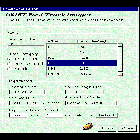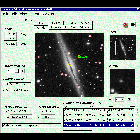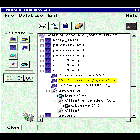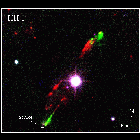


The ORAC project was set up to improve the efficiency and ease of observing at UKIRT. All of the software that interacts with the observer is replaced with a set of integrated tools to take the observer from detailed pre-observing preparation of observations to data reduced on-line at the telescope. The software consists of modules for each stage of the observing process, as summarised in the list below.
| ORAC-OT | The ORAC Observing Tool allows you to specify your observing programme "at home" and submit it to a database at UKIRT. It is based on the Gemini Observing Tool. |
| ORAC-OM | The ORAC Observing Manager retrieves your programme from the database and allows you to select which observation to do next. |
| ORAC-OS | The ORAC Observation Sequencer executes the observation and provides a user interface to allow you to control the progress of the observing (e.g. to pause or stop). |
| ORAC-DR | The ORAC Data Reduction provides pipeline reduction of the data as it is obtained using the recipe specified with your observing programme. ORAC-DR is already in use at UKIRT for UFTI and IRCAM data, and will be released on the spring 2000 Starlink CD. |
The ORAC software was integrated with the UFTI instrument and successfully commissioned at UKIRT in October 1999. One of the first commissioning tests was to take a make a large mosaic of the spiral galaxy NGC891, with all stages of the observing controlled by ORAC as illustrated below.
The observations were prepared using the ORAC-OT:
ORAC was tested for all the different kinds of observing UFTI is capable of, including photometry of faint sources, narrow band imaging and moving targets. Each UKIRT astronomer prepared a 2 hour observation and used the ORAC-OT, ORAC-OM, ORAC-OS and ORAC-DR to prepare, take and reduce their data.
| The spectacular image of HH1 shown here is one of several exciting results. The red shows H2 emission, the green [FeII] emission. |  |
Observing with ORAC was clearly more efficient than with the current system, and the system worked very well overall. UKIRT has decided that rather than use ORAC for observing with UFTI immediately, and switch between the old and the new systems, they would like to implement ORAC for CGS4 and IRCAM as soon as practicable. The current plan is that ORAC will be used for all UKIRT instruments and by all observers from May 1st 2000, and the UKIRT software group and ORAC team are now working to achieve this. User guides for the ORAC-OT and ORAC-OM/OS will be available soon.